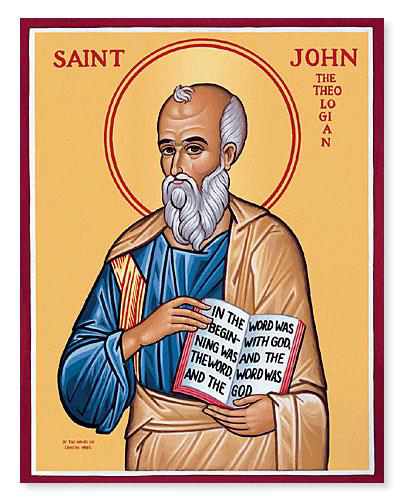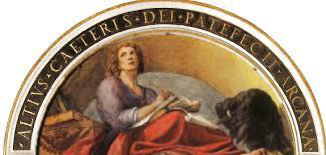St. John The Evangelist

Brethren, we are indebted to Wor Bro Richard Num Secretary of Irish Constitution Lodge No 363, Adelaide, South Australia, for forwarding the attached notes on St John the Evangelist, to mark this, his annual festival. Richard shall be back in Ireland during 2015, and I’m sure we all look forward to renewing old acquaintances on his return.
On or about the twenty-seventh day of this month; Freemasons, throughout the world, will assemble to celebrate the festival of one of our patron saints, the loving Evangelist. In the earlier history of the Craft, Freemasons were especially remarkable for their observance of these anniversaries. A hearty appreciation of the full significance attached to them, made the times and seasons, the new moons and the full moons, the solstices and the equinoxes, occasions not merely for the interchange of fraternal greetings, but opportunities for the acquisition of solid Masonic knowledge, and for the cultivation and strengthening of those great precepts of Freemasonry; Brotherly Love, Relief and Truth.
There is no proof, of course, that St. John the Evangelist was ever functional Patrons of our Fraternity, and they most certainly was not an Operative or Speculative Mason, but it is a fact that Freemasonry has adopted him as Patron Saint for several centuries. Legend has set December 27th as St. John the Evangelist’s “birthday” and history depicts him as an introvert and a man of thought, meditation, and vision. John the Evangelist was a Galilean, and the cousin of Jesus. In his early years, he was impulsive, impetuous, and vindictive as evidenced by the time he wanted to call down fire from Heaven. During that period of his life, the Christian Master called him and his brother, James, the “Sons of Thunder”. In his later years, his disposition mellowed, and he became known as the Disciple of Love or, in Masonic terminology, “Brotherly Love.”

It is known that John the Evangelist wrote one Gospel, three Epistles and the book of Revelations. For those that are members of the Eastern Star, it is interesting to note that his Epistles were written to an “Elect Lady” who later became Electa in the Eastern Star ritual. Many Masonic scholars hold that the Gospel of St. John is of vital importance to all Freemasons – not for its Christian theology — but for the lessons of Brotherly Love that are contained therein.

The original reason for the choice of this particular Patron Saint has been obscured by the passage of time. We cannot determine exactly why our ancient Brethren chose him or St John the Baptist rather than St. Thomas, a stonemason. An old Latin document of our Order deposited with a Lodge in France, includes a proclamation of the Masons of Europe assembled at Cologne in 1535. It declares that Masons were called, “Brethren dedicated to St. John, first among the stars of the morning.” It further tells us that prior to 1440, the Fraternity was called the “Joannite Brothers” (John’s Brethren). It was about at that same time that we began to be known by the name, “Free Masons”.
The Theological Virtues of Faith, Hope, and Charity – normally represented as the top three rungs on Jacob’s Ladder in Christian religious art — are mentioned in our rituals. Thomas Paine, a Freemason, wrote in the following in his book entitled, “Origin of Freemasonry”:
“The high festival of the Masons is on the day they call St. John’s Day, but every enlightened Mason must know that holding their festival on this day has no reference to the person called St. John, and that it is only to disguise the true cause of holding it on this day that they call by that name. As there were Masons many centuries before the time of St. John, the holding their festival on this day refers to a cause totally unconnected with either of the Saints John.”
Many of Freemasonry’s most knowledgeable scholars believe that the real explanation of Freemasonry’s connection with the Holy Saints John Festival Days is not to be found in the history of the Craft – but, rather, in the history of ancient religions. These festival days are as old as the ancient systems of worship of fire and Sun. The greatest manifestation of nature known to our ancient ancestors was the Sun. It was always present during the day, and its near kin, fire, warmed and comforted them at night. Under its gentle rays, crops grew and rivers rose. The Sun kept away the wild beasts by its light. Sun worship and fire worship were just as natural for men just struggling into understanding, as was the breath they drew. Early man must have observed the Sun’s slow movement from north to south during the year and back again as the seasons waxed and waned. Therefore, Midsummers’ Day, the longest in terms of Sunlight, became a festival; it was the harbinger of life, just as the Winter Solstice was significant of the end of the slow decline of the Sun.

Technically, we now know that the seasons of the year are caused by the 23.5º tilt of the Earth’s axis. Because the earth is rotating like a top or gyroscope, it continuously points in a fixed direction toward a point in space near the North Star. However, the Earth is also revolving around the Sun at the same time. During half of the year, the Southern Hemisphere is closer to the Sun than is the Northern Hemisphere. During the rest of the year, the reverse is true. At noontime in the Northern Hemisphere, the Sun appears high in the sky during Summer and low in the sky during Winter. These two extremes are referred to as a “solstice.” Primitive man did note the change in the Sun’s movement as evidenced by astronomical observatories, such as Stonehenge on the plains of southern England.
“Solstice” is derived from two Latin words: “Sol” meaning, “sun”, and “sistere” meaning, “to cause to stand still”. The lowest elevation occurs about December 21st and is the Winter Solstice — the first day of winter when the night-time hours (darkness) are at a maximum and the period of sunlight is at its minimum.

In ancient Egypt, for example, the god Osiris died and was entombed on December 21st and reborn on December 25th. In the earliest days of Ancient Greece, a man was selected to be a representation of the god Dionysus during the Feast of Lenaea (Festival of the Wild Women). It was on that day of the Winter Solstice that Dionysus died and was then resurrected on December 25th. During the festival, the man being “honoured” was literally torn to pieces, and the pieces were then eaten by the women.
By classical times in ancient Greece, the human sacrifice had been replaced by the killing of a goat. The goat later became the symbol for Capricorn. In Astrology, December 27th, St. John the Evangelist’s Festival Day falls under the zodiac sign of Capricorn (December 22nd – January 19th).

Ancient Rome had dozens of gods for every purpose imaginable. By 300 BCE, the Roman Empire had combined the festivals for those gods under the name of “Dies Natalis Solis Invicti” (“Birthday of the Unconquered Sun”). This was a weeklong festival commencing on December 21st and ending on December 27th with the main feast day taking place on December 25th. It was a feast honouring the renewal of the Sun at the Winter Solstice. It included feasting, dancing, lighting bonfires, decorating homes with greens, and the giving of gifts – much like the traditions of our present-day Christmas season. Virtually all of the so-called ancient pagan religions included the nativity, death, and rebirth of a “man-god/saviour”, and then the ascension of the resurrected to “heaven” where he watched over his flock while they were here on Earth. It was, in fact, the story of the nativity, death, and resurrection of the Christian Master – and it was thousands of years old before the birth of the Christian religion. This ancient legend can be traced back to at least 6500 BCE.

The early Church wanted these pagan festivals stopped, but they were very popular with the people. The solution to the problem was simple; substitute Christian meanings and Saints for pagan gods on these holidays and continue to celebrate the same ceremonies on the same dates – but under a different name. The Church felt that including this holiday into Christian observances would eventually convert those who followed the “Olde Way”. The selection of December 25th as a Christian holiday was first recorded in scholarly texts in 325 AD, although the actual practice was first decreed in 274 A.D. by the Emperor Aurelian. Since non-Christians viewed this date as the rebirth of the Sun, it made perfect sense for the Church to also mark this period as the celebration of the nativity of Yeshua ben Nazareth (Jesus). If the Church could not replace pagan holidays and celebrations, it would simply adopt them and incorporate so-called pagan symbolism into its own.

Therefore, the celebration of the Summer Solstice became the Festival of Saint John the Baptist and the celebration of the Winter Solstice became the Festival of Saint John the Evangelist. The High Festival Day of the Romans became the birth date of the Christian Master.
However, it took centuries for the tradition of St. Johns’ Days and Christmas to catch on. For example, it was adopted in Ireland in the 5th century AD; the 7th century in Eastern Mediterranean countries; Austria, England and Switzerland adopted them in the 8th century; and the Slavic countries in the 9th and 10th centuries.
St. John the Evangelist teaches us to subdue our passions, one of the first lessons every new Freemason learns in Lodge. When we examine the writings of St. John the Evangelist, we see a major transformation of a young man. He goes from being a hot-tempered young radical to one who exhibits peace in his old age. He goes from being intolerant of others to working with others by sharing his theology of a “better way of life”. Above all things, John was loyal. He was the only Disciple to attend the trial of Jesus as well as being at the foot of the cross for the crucifixion. When he heard about the empty tomb on that eventful Sunday morning, he was the first Disciple to arrive. Moreover, it was he that took Mary, the mother of Jesus, into his home and cared for her until her death.
We know from the writings of St. John the Evangelist that his message is simple and straightforward — that to know and love God is to obey His law, that the essential mark of grace is Brotherly Love, and that the ideal life is to live in fellowship with others.

It does not matter that there is no, nor never was, a Lodge of the Holy Saints John at Jerusalem. It does not matter whether the two Saints John were actually members of the Masonic Fraternity. They were selected as our Patron Saints because they exemplified the basic principles of our ancient Fraternity in their daily lives through their words and deeds. It is because Freemasonry regards the character and internal qualifications of a man that the two Saints John are fitting Patrons. Freemasonry honours them because they were living examples of the Golden Rule and their practice of love for their fellowmen, and their love of their Creator.


